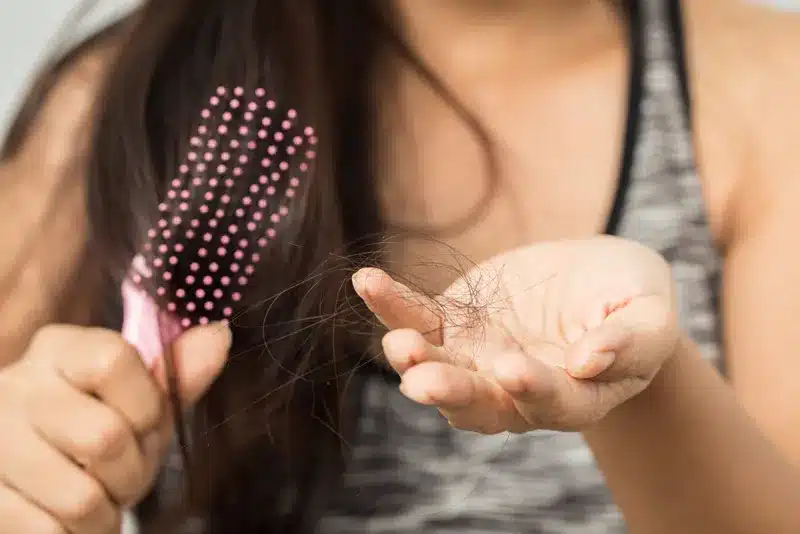Women experience various forms of hair loss. The most common type is “androgenic hair loss,” characterized by thinning hair due to hormonal imbalance, particularly testosterone dominance. This condition can develop when hormones become disrupted at any stage. It typically appears between ages 45-55, coinciding with declining estrogen and progesterone levels and increased likelihood of thyroid dysfunction.
Available treatment options include:
- Hormone balancing with testosterone to regulate estrogen and progesterone
- Thyroid medication like thyroxine for hypothyroidism
Losing 50-100 hairs daily is normal as part of the hair renewal cycle. Excessive hair loss caused by androgen excess (testosterone) and/or thyroid deficiency accounts for 95% of hair loss cases.
Causes of Female Hair Loss
Elevated dihydrotestosterone (DHT) levels – a potent testosterone variant – primarily cause female hair loss. Some women have scalp follicles particularly sensitive to DHT. DHT production increases when regular testosterone converts due to declining estrogen and progesterone levels.
Thyroid hormone deficiency (hypothyroidism) also contributes, often accompanied by fatigue and weight gain.
Hair Loss Prevention Strategies
Begin with hormone level testing to evaluate estrogen, progesterone, testosterone (including DHT), and thyroid hormone balance. If deficiencies exist, hormone replacement therapy (HRT) may effectively address menopausal symptoms including hair thinning.
Nutrition and nitric oxide levels are equally important. Nitric oxide supports sexual and cardiovascular health while potentially preventing hair loss.

Key principles for hair health:
Balanced Nutrition
Maintain a 33% protein, 33% carbohydrate, 33% fat ratio. Limit refined carbs and saturated fats.
Gradual Improvement
Implement changes through small, sustainable steps rather than drastic measures.
Vitamin Supplementation
Address aging-related nutritional needs with comprehensive multivitamins. The body absorbs required nutrients and eliminates excess.
Regular Exercise
Start with simple activities (stairs, walking) and progress to 30-minute sessions 4-5 times weekly.
Stress Management
Chronic stress elevates cortisol, damaging tissues and inhibiting growth hormone. Practice relaxation techniques like deep breathing.
Female Hormone Imbalance Indicators
Common hormonal imbalance symptoms and their meanings:
| Symptom | Potential Cause |
| Hot flashes | Low estradiol |
| Mood swings | Low estradiol |
| Vaginal dryness | Low estriol |
| Abnormal bleeding | Estradiol excess/progesterone deficiency |
| Hair loss/Facial hair | Testosterone dominance from low estrogen/progesterone or hypothyroidism |
| Low libido | Low free testosterone |
| Breast tenderness | High estradiol/low progesterone |
| Dry skin | Low estradiol, estriol and/or thyroid |
| Water retention | Low progesterone |
| Fibroids/cysts | Estrogen excess/progesterone deficiency |
| Brain fog | Low estrogen, testosterone or thyroid |
| Depression | Low estrogen, testosterone or thyroid |
| Fatigue | Low estrogen, testosterone or thyroid |
| Anxiety | Low progesterone and/or thyroid |
| Osteoporosis | Low estradiol, progesterone or testosterone |

Essential Female Hormones
Androgenic hair loss signals hormonal imbalance. Understanding key hormones is crucial for prevention.
Estrogen Types
- Estradiol: Most potent estrogen; relieves hot flashes/mood swings but carries higher cancer risk
- Estrone: Produced by fat cells; persists post-menopause
- Estriol: Mildest estrogen; abundant during pregnancy; helps vaginal dryness, dry skin, hair loss
Progesterone
Protects against osteoporosis and balances estrogen effects.
Testosterone
Maintains bone density, mental acuity, muscle mass, metabolism, energy and sexual function.
Thyroid Hormone
Critical for overall hormonal function. Declines with age, causing hypothyroidism that contributes to hair loss. Treatment can restore hair growth.
Thyroid hormone is arguably women’s most vital yet frequently underdiagnosed hormone. Low thyroid function affects many women over 40.
Hypothyroidism Symptoms
Women are particularly susceptible to hypothyroidism as thyroid hormones decline with age. Common symptoms include:
- Persistent fatigue
- Cold intolerance (consistently low basal temperature)
- Thinning hair (often overlooked by physicians)
- Dry skin, hair and brittle nails
- Anxiety, irritability and sleep disturbances
- Depressive symptoms
- Elevated cholesterol
- Cognitive impairment
- Reduced metabolism leading to weight gain
Reference:
Mayo Clinic: Androgenic Alopecia – Not Just a Male Condition







